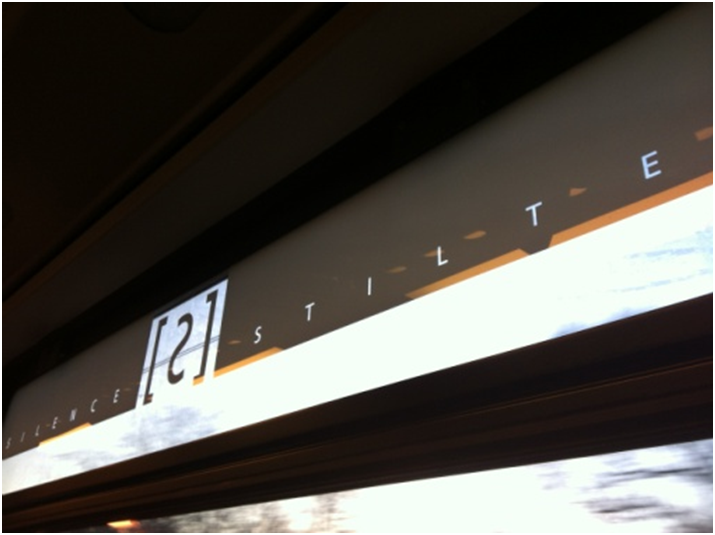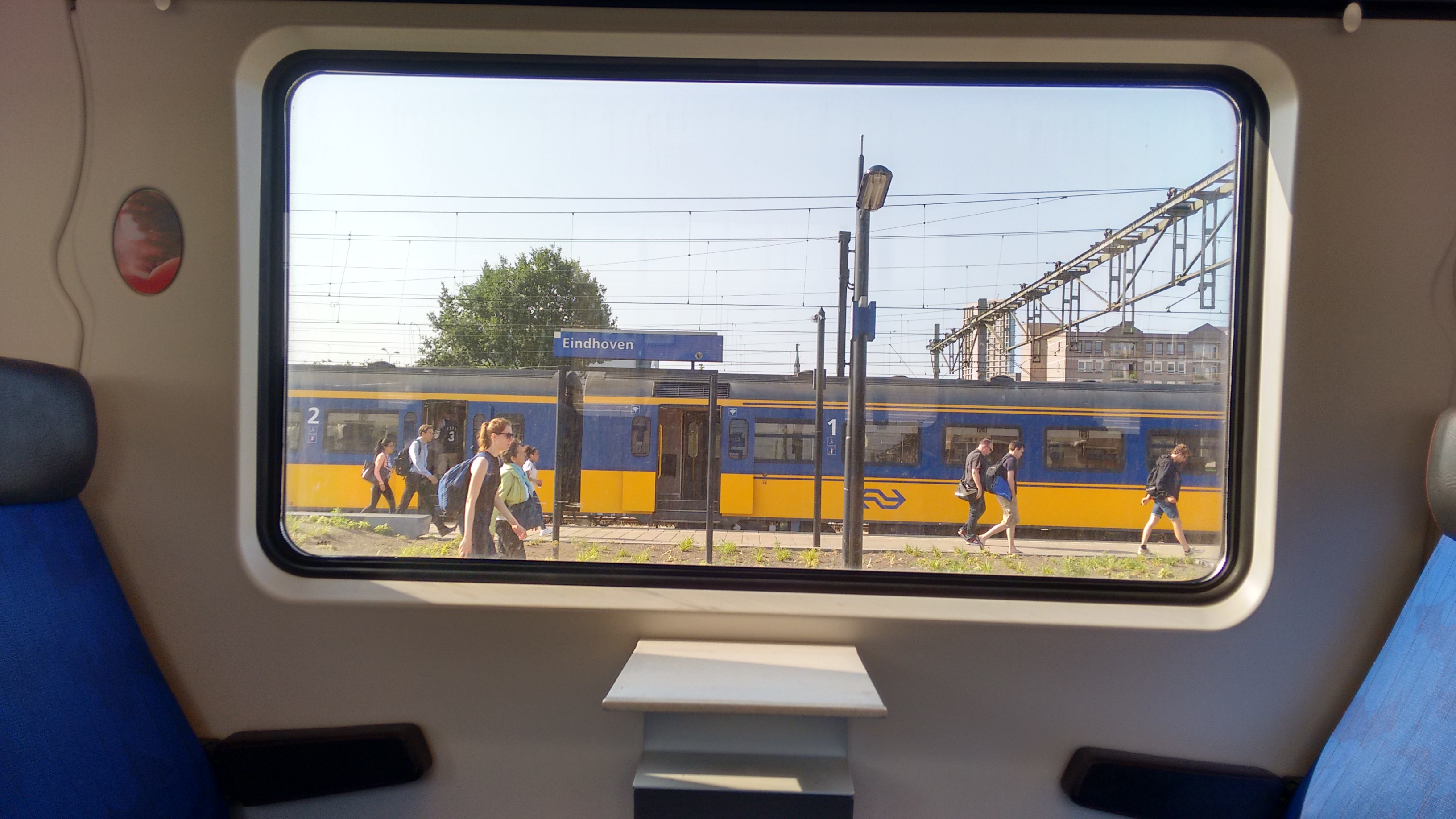What do you think? The Stiltecoupé Posted by Sten on May 2, 2016 in Culture, Dutch Language, Dutch Vocabulary, News
In most Intercity’s (intercity train – high speed trains) of Nederlandse Spoorwegen (NS) (Dutch Railways – NS, the main railway company), you will find a stiltecoupé (silence train compartment), in which you are not allowed to talk. Intended for people that want to travel in silence, because they read a book, need to focus on some work, want to do a dutje (nap), or just because they like it stil (quiet).
Reizigers houden zich niet aan de regels

Stilte! Decals (also in English!) on the windows tell you that in this coupé, it has to be quiet!
The stiltecoupé, or as NS itself wants to call it, the stiltezone (silence zone) was introduced in 2003. In dubbeldekkers (double-deckers), the stiltecoupé is always the upper deck, because reizigers (travelers) that care about the stiltecoupé prefer that.
Geweldig, toch? (Great, right?) However, NS has received many klachten (complaints) over the years, because allegedly many people do not follow the huisregels (house rules) and talk anyway! There are, of course, conducteurs (conductors) who are supposed to terechtwijzen (reprimand) the praters (talkers).
After onderzoek (research), NS found out that this does not always happen, however. Obviously, the conducteurs are not always present in every stiltecoupé. Also, most reizigers are aware that they are in a stiltecoupé, but keep talking anyway. And so reizigers themselves have to ask the praters to be quiet.
Onbeleefd (Rudely): Wees nou eens stil! Dit is een stiltecoupé! (Just be quiet now! This is a silence compartment!)
Beleefd (Politely): Wilt u alstublieft wat zachter praten? U zit in een stiltecoupé. Dank u wel! (Would you please talk a little softer? You are sitting in a silence compartment. Thank you!)
Either way, reactions can differ. The reiziger rather asks kletsende (chatting) older ladies for silence than a bellende (phoning) muscly guy. What if they react aggressively?
Meningen van reizigers

An NS train at the perron (platform) of station Eindhoven, from a regular coupé.
The only aanduiding (indication) that shows you that you are in a stiltecoupé are the window decals, icons on the outside of the treinstellen (train coaches), and some on the inside. The displays in each coupé also show how to behave in a stiltecoupé (in een stiltezone moet het écht stil zijn (in a silence zone it has to be really quiet), but does not say whether you are in one or not. Many reizigers think that the stiltecoupés are not indicated sufficiently. In the Volkskrant of zaterdag (Saturday), some reizigers expressed their meningen (opinions) about this.
Pierre says: “De stilte-aanduiding buiten de treinstellen en binnen de coupés [is] onvoldoende en onduidelijk. Daar hoef je geen onderzoek voor te doen. Dat ziet een kind.” (The silence indication outside the train coaches and inside the compartments [is] insufficient and unclear. You don’t need to do research for that. Even a child sees that.)
Dirk gives a few points that could be improved about the onduidelijkheid (uncertainty) of the stilte-aanduiding. He says the deuren (doors) should say that you are entering a stiltecoupé, the kind of deuren should be different than the regular deuren, and should and should cancel outside noise, and every stoel (chair) should have the silence icon on the headrest.

The new stiltecoupés NS used for a test, with the silence icon on every headrest in a stiltecoupé (Image by NS).
Roeland and Mr Boon say that it is odd that there are vierzitters (four seaters, as on the picture above) in a stiltecoupé. “Zitjes voor vier zijn impliciete uitnodigingen voor gesprek“, (Seats for four are implicit invitations for conversation) thinks Mr Boon.
Mijn mening
I must agree with them. Currently, the silence zones are not indicated properly, and should get a different atmosphere than the regular coupés. In new trains, NS placed a loungebank (lounge couch) in the lower decks of dubbeldekkers, as to invite people to talk with each other there, and the upper decks are for reading and working, but talking is still allowed. Next to these two zones, there are still some stiltecoupés. So now there are even three zones, instead of just two. Here is my opinion:
Ik vind dat de stiltecoupés op dit moment niet voldoende zijn aangeduid. Er moeten meer aanduidingen komen die al bij het binnenkomen duidelijk maken dat je in een stiltecoupé bent. Alleen wat pictogrammen toevoegen zal niet helpen. De hele sfeer moet veranderen in een rustigere, misschien zelfs bibliotheekachtige sfeer. Daar zou ik me echt op mijn gemak voelen als ik stilte wil hebben. En ik denk ook dat anderen zich eerder aan de stilteregels zouden houden met zo een sfeer.
(I think that silent compartment are not indicated sufficiently at the moment. More indications have to come that already make it clear at entrance that you are in a silence compartment. Only adding some icons wil not help. The entire atmosphere has to change into a calmer, maybe even library-like atmosphere. There, I would really feel comfortable if I want silence. And I also think that others will rather comply with the silence rules with such an atmosphere.
Wat denk jij?
What do you think? Write your own opinion in a few sentences below in the comments!
For questions, suggestions etc., you can also contact me on Facebook by clicking on the button below!

Build vocabulary, practice pronunciation, and more with Transparent Language Online. Available anytime, anywhere, on any device.
About the Author: Sten
Hi! I am Sten, both Dutch and German. For many years, I've written for the German and the Dutch blogs with a passion for everything related to language and culture. It's fascinating to reflect on my own culture, and in the process allow our readers to learn more about it! Besides blogging, I am a German-Dutch-English translator, animator and filmmaker.





